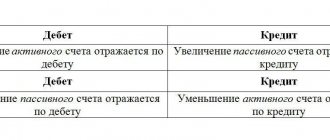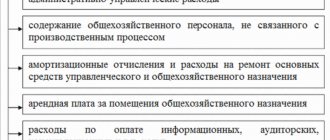Account 99 Profits and losses
Net profit (net loss) consists of the following components:
| Profit (loss) from sales | +- | Balance of other income and expenses | — | Income tax +- Payments for recalculation of income tax + Sanctions for violations of tax legislation | = | Net profit (loss) for the reporting period |
During the month, revenue and expenses for ordinary activities are recorded on account 90, other income and expenses on account 91.
When closing the month, the financial result is taken into account in account 99 Profit and loss. When making a profit in the reporting period, the following entry is made:
Debit 90-9 Credit 99 - profit from sales is reflected (the final turnover of the reporting month).
When a loss is incurred in the reporting period, the following entry is made:
Debit 99 Credit 90-9 - loss from sales is reflected (the final turnover of the reporting month).
When the amount of income exceeds the amount of expenses, the following entry is made:
Debit 91-9 Credit 99 - profit from other activities of the organization is reflected (the final turnover of the reporting month).
When the amount of expenses exceeds the amount of income, the following entry is made:
Debit 99 Credit 91-9 – reflects the loss from other activities of the organization (the final turnover of the reporting month).
Reflection of penalties
As we have already found out, account 99 should reflect all amounts of tax penalties. Write-off of debt on them should also be reflected using account 99.
Postings:
- when calculating punitive tax sanctions - Dt 99 Kt 68;
- when transferring fines to the budget - Dt 68 Kt 51.
You will receive information about how financial sanctions are recognized from the article “What actions of the debtor confirm his recognition of sanctions?”
Tax sanctions
If the tax inspectorate has assessed fines for violation of tax rules with income tax or similar taxes (UTII, Unified Agricultural Tax, single tax paid when applying the simplified tax system), which the organization does not intend to challenge, they are reflected in the accounting records as of the date of the decision to prosecute:
Debit 99 Credit 68 - a fine was assessed for violation of income tax rules.
Fines for violation of tax rules for other taxes, fines and penalties for insurance premiums, fines for late submission (failure to submit) of any declarations and reports to the Pension Fund are charged to other expenses and taken into account in account 91 on the date of the decision to prosecute.
The taxable profit of the amount of penalties, fines and other sanctions accrued for violations of tax legislation is not reduced (clause 2 of Article 270 of the Tax Code of the Russian Federation).
***
Which account is the profit (loss) of the enterprise reflected in? Account 99 is intended for this purpose, which reflects the financial results of the organization for a certain period of time. This result is then entered into Form No. 2 of the financial statements “Report on Financial Results”. This accounting account is active-passive: a positive debit balance means a loss at the end of the financial period, and a credit balance means a profit. At the end of each reporting period, it is necessary to close account 99 to reset the balances. Sub-accounts can be opened to this account for a more detailed reflection of transactions.
Closing account 99 at the end of the year
At the end of the year, the balance sheet is reformed - all subaccounts to accounts 90, 91 and 99 are closed with internal entries. After this, the balance remains only on subaccount 99.01. This is the financial result of the reporting year; it is written off to account 84.
Reformation of the balance sheet is the final operation of the reporting year. As of January 1 of the following year, the balance in account 99 should be zero.
If at the end of the reporting year a profit is made (the account balance is 99 credits), the following entry is made:
Debit 99 Credit 84 - reflects the net profit of the reporting year.
If at the end of the reporting year a loss is received (account balance 99 is debit), the following entry is made:
Debit 84 Credit 99 - reflects the net (uncovered) loss of the reporting year.
Is credit a profit or a loss? What does account credit 99 show?
Account credit 99 shows the company's income. Income is the sum of all income received by an organization into a bank account for a specific time interval. Income includes: revenue, profit from transactions with securities, interest received on deposits, income from leasing property, etc. The credit of account 99 is in correspondence with accounting accounts 90, 91, 73, etc. For example, income received from Sales of goods produced or services provided are reflected by posting Dt 90 Kt 99.
Thus, it is important to answer the question: is the credit of 99 accounts a profit or a loss? The loan shows the company's profit, i.e. it has a positive credit balance at the end of the reporting period.
Subscribe to our newsletter
Yandex.Zen VKontakte Telegram
Instructions 99 count
Instructions for using the chart of accounts for accounting the financial and economic activities of organizations in accordance with Order No. 94n dated October 31, 2000:
Account 99 “Profits and losses” is intended to summarize information on the formation of the final financial result of the organization’s activities in the reporting year. The final financial result (net profit or net loss) is made up of the financial result from ordinary activities, as well as other income and expenses.
The debit of account 99 “Profits and Losses” reflects losses (losses, expenses), and the credit shows the profits (income) of the organization. A comparison of debit and credit turnover for the reporting period shows the final financial result of the reporting period.
Account 99 “Profits and losses” during the reporting year reflects:
- profit or loss from ordinary activities - in correspondence with account 90 “Sales”;
- balance of other income and expenses for the reporting month - in correspondence with account 91 “Other income and expenses”;
- the amount of accrued conditional income tax expense, permanent liabilities and payments for recalculation of this tax from actual profit,
- as well as the amount of tax penalties due - in correspondence with account 68 “Calculations for taxes and fees”.
At the end of the reporting year, when preparing annual financial statements, account 99 “Profits and losses” is closed. In this case, by the final entry of December, the amount of net profit (loss) of the reporting year is written off from account 99 “Profits and losses” to the credit (debit) of account 84 “Retained earnings (uncovered loss)”.
The construction of analytical accounting for account 99 “Profits and losses” should ensure the generation of data necessary for drawing up a profit and loss statement.
Account 99: what does debit and balance show?
The debit of account 99 shows the expenses and losses of the organization. Expenses are the total amount of expenses that were incurred by the enterprise for a certain period (year, quarter, month) based on the results of its activities. These costs include funds spent on raw materials and materials, acquisition of fixed assets, compensation of workers, operation of vehicles, etc. Expenses are in correspondence under the loan with accounting accounts 01, 03, 10, etc. For example, as a result of an emergency the company lost its own products - Dt 99 Kt 41.
You can find more complete information on the topic in ConsultantPlus. Free trial access to the system for 2 days.
The most important accounting indicator is the accounting balance 99, which is the difference between financial profit and expenses. This indicator appears as a result of the production and sale of goods. The balance is determined at the beginning and at the end of a certain time interval, and, accordingly, is called initial or final.
The goal of every organization is to make a profit. If the balance of account 99 at the end of the reporting period turned out to be a debit, this means that the level of profit was lower than the level of costs. If the balance is negative, the company made a profit for the selected period of its operation.
Below is the answer to the question, Kt 99 of the account is profit or loss.
Typical transactions for account 99
By debit of the account
| Contents of a business transaction | Debit | Credit |
| The amount of tax accrued for the reporting period | 99 | 68 |
| A fine was assessed for violating the rules of taxation with income tax (UTII, Unified Agricultural Tax, tax paid when applying the simplified tax system) | 99 | 68 |
| The net profit of the reporting year is reflected during the balance sheet reformation | 99 | 84 |
| Reflected loss from ordinary activities | 99 | 90-9 |
| Reflected loss from other activities | 99 | 91-9 |
Closing the reporting period
At the end of each reporting period, companies must close account 99, and at the beginning of the next year, open it again. These operations are necessary in order to have an idea of the results of the enterprise and its level of profitability.
Accounting reporting periods coincide with tax periods, therefore, resetting account balances 99 to zero is also necessary in order to make timely and complete tax payments.
The balance at the beginning of the next period should be zero. To close account 99, you must first close the accounts associated with it. These include:
- Account 90 “Sales”. This reflects income from the sale of goods and services that were produced as a result of the company’s activities. To detail accounting transactions for this accounting account, subaccounts are opened for it: 90.1, 90.2, 90.3, 90.9.
Account 90 is closed with the following transactions:
Dt 90.1 Kt 90.9
Dt 90.9 Kt 90.2
Dt 90.9 Kt 90.3
- Account 91 “Other income and expenses.” It is formed on the basis of other income and expenses of the company. The most used subaccounts for this accounting account are: 91.1, 91.2, 91.9.
After these accounts are closed, the total for account 99 and the final balance are displayed. If a positive amount is obtained from the debit account, then a loss is formed; if such a value appears on the credit account, a profit is formed.
Then a posting is made to account 84, where retained earnings (Dt 99 Kt 84) or loss (Dt 84 Kt 99) are reflected, and the account is closed. The balance on it remains zero.
Uncovered loss
The decision on how to pay off the resulting loss is also made by the owners (founders) of the organization (general meeting of shareholders or meeting of participants in an LLC).
The loss can be repaid through:
- targeted contributions from shareholders (participants) of the organization;
- reserve capital funds;
- funds of retained earnings from previous years.
In the first two cases, entries are made to the credit of account 84:
Debit 75 (70) Credit 84 sub-account “Uncovered loss” - targeted contributions from the organization’s shareholders (participants) were sent to repay the loss.
Debit 82 Credit 84 subaccount “Uncovered loss” - reserve capital funds were used to repay the loss.
If the owners of the organization decided to pay off the loss using retained earnings from previous years, an entry is made in the accounting to the subaccounts of account 84:
Debit 84 subaccount “Retained earnings” Credit 84 subaccount “Uncovered loss” - retained earnings from previous years are used to repay the loss.
The loss can also be written off from the balance sheet if the general meeting decides to reduce the authorized capital to the amount of the organization’s net assets.
After the corresponding changes in the constituent documents have been registered, make the following entry:
Debit 80 Credit 84 subaccount “Uncovered loss” - the authorized capital is reduced to the amount of the organization’s net assets.
What records are needed?
When account 99 is regularly closed, balances are formed after other accounts are reset to zero. In particular, 99.01 is created in correspondence with 90.09 “Profit/loss from sales”.
Typically, an enterprise opens an additional subaccount 99.01.1 “Profits and losses from activities with the main tax system.” Profit will be accumulated on credit, loss on debit:
- Dt 90.09 Kt 99.01.1 – profit came out;
- Dt 99.01.1 Kt 90.09 - loss written off.
90.09 is created using the formula:
- revenue - cost - VAT.
To calculate income tax, you need to carry out correspondence 99.02 with 68.04 “Income Tax”. The tax can be not only payable, but also refundable, so it is reflected as a debit or credit:
- Dt 68.04 Kt 99.02 - in case of loss;
- Dt 99.02 Kt 68.04 - profit was made.
In addition to direct posting, income tax is generated from the reduction of turnover:
- conditional income on subaccount 99.02.2;
- conditional consumption as of 99.02.1;
- permanent tax liabilities (assets) as of 99.02.3;
- calculation of deferred tax liabilities and assets as of 02/99/4.
These subaccounts are maintained by organizations whose tax and accounting records differ significantly.
As for 99.03, unlike other subaccounts, it directly corresponds with the asset and cost accounts. 99.03 is used to reflect losses resulting from natural disasters and emergencies. That is, the following wiring will be used:
- Dt 99.03 Kt 01 (07, 08, 10, 41, 20, 23, 25, 26).
Tax fines and penalties increase losses when interacting with 99.06:
- Dt 99.06 Kt 68 “Calculations for taxes and fees.”
Accounting entry D99 K09 is formed in the following cases:
As part of the application of PBU No. 18/02 Account. 09 “Deferred tax assets” (DTA) summarizes information about the movement of tax assets. Small business organizations have the right not to apply this PBU. IT includes the amounts of deferred tax liabilities for deductible temporary differences. Accounting for such values is organized separately for all types of assets.
Upon disposal of any item on which a temporary difference arose, the amount of deferred tax assets is written off. To do this, a standard posting is made: Debit 99 Credit 09 for the full amount of the disposal.
Example of writing off SHE:
The company purchased equipment in the amount of 700,000.00 rubles with a useful life of 5 years. The method of calculating depreciation in accounting is the reducing balance method, and in tax accounting it is linear. For the current calendar year, depreciation expenses were accrued: for accounting purposes - 233,333.33 rubles; for tax accounting purposes – 140,000.00 rubles.
The amount of the difference deducted = 233,333.33 – 140,000.00 = 93,333.33 rubles. SHE = 93333.33 x 20% = 18,666.67 rubles, the posting is made: Debit 09 Credit 68 for 18,666.67 rubles.
When an item of fixed assets is disposed of, for example, as a result of a sale, a posting is made: Debit 99 Credit 09 for 18,666.67 rubles for the disposed fixed asset.
Correspondence with other accounts
Account 99 corresponds with many accounts in accounting. For debit 99, the corresponding ones are:
- Section 1 “Non-current assets” -03, 07, 08.
- Section 2 “Inventory” - 10, 11.
- Section 3 “Production costs” - 20, 21, 23, 25, 26, 28, 29.
- Section 4 “Finished products and goods” - 41, 43, 44, 45.
- Section 5 “Cash” - 50, 51, 52, 58.
- Section 6 “Calculations” - 68, 69.
- Section 7 “Capital” - 84.
- Section 8 “Financial results” - 90, 91, 94.
Typical correspondence
Regarding the loan, correspondence goes as follows:
- Section 2 “Inventory” - 10.
- Section 5 “Cash” - 50, 51, 52, 55.
- Section 6 “Calculations” - 60, 73, 76, 79.
- Section 7 “Capital” - 84.
- Section 8 “Financial results” - 90, 91, 94, 96.
Debit 99 credit 09
This is a posting for writing off the amount of ONA. PBU 18/02 describes 2 cases of write-off of IT:
- If the tax rate changes, then the accumulated IT is changed by recalculating the balance of deductible temporary differences (DTT) at the new rate. The difference between the accumulated and recalculated amounts is posted to account 99, as required by the regulations.
- If the asset that determined the accrual of the tax is disposed of, then the tax is subject to write-off to the extent that the profit for taxation will not be reduced in accordance with the legislation of the Russian Federation.
If the accounting of VVR and ONA is carried out correctly, then IT, as a rule, is completely repaid with a decrease in VVR. If accounting errors have been identified, then when they are corrected, it may be necessary to write off IT as a loss.
Cases of write-off of IT of the same kind are reflected in the same way in accounting: Dt 77 Kt 99.
Use of profits
The decision on the distribution of net profit is made by the owners (founders) of the organization at the general meeting of shareholders (in a JSC) or the general meeting of participants (in an LLC). This decision is usually made at the beginning of the year following the reporting period.
The distribution of net profit is within the exclusive competence of the general meeting of participants (shareholders) and cannot be carried out by the sole direction (order) of the head of the organization.
The meeting of shareholders (participants) of the organization may decide not to distribute the profit received at all (or leave some part of it undistributed).
Net profit can be used for:
- payment of dividends to shareholders (participants) of the organization;
- creation and replenishment of reserve capital;
- repayment of losses from previous years.
In the first two cases, the use of net profit is reflected in the debit of account 84:
Debit 84 subaccount “Profit subject to distribution” Credit 75 (70) – dividends accrued to shareholders (participants) of the organization;
Debit 84 subaccount “Profit subject to distribution” Credit 82 – net profit was directed to the creation and replenishment of the organization’s reserve capital.
If the owners of the organization decided to use the net profit to pay off losses of previous years, an entry is made in the accounting for the subaccounts of account 84:
Debit 84 subaccount “Profit subject to distribution” Credit 84 subaccount “Uncovered loss” - net profit is aimed at paying off losses of previous years.
After you have recorded the use of profits (repayment of losses), the balance in the “Profit to be distributed” subaccount of account 84 shows the amount of retained earnings. This amount can be transferred to the appropriate subaccount:
Debit 84 subaccount “Profit subject to distribution” Credit 84 subaccount “Retained earnings” - reflects the amount of the organization’s retained earnings.








